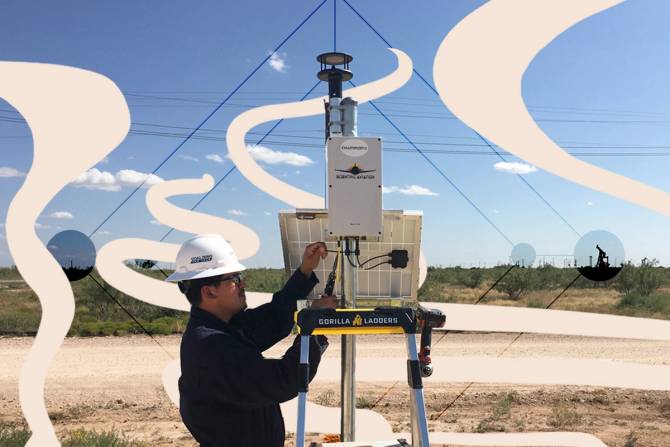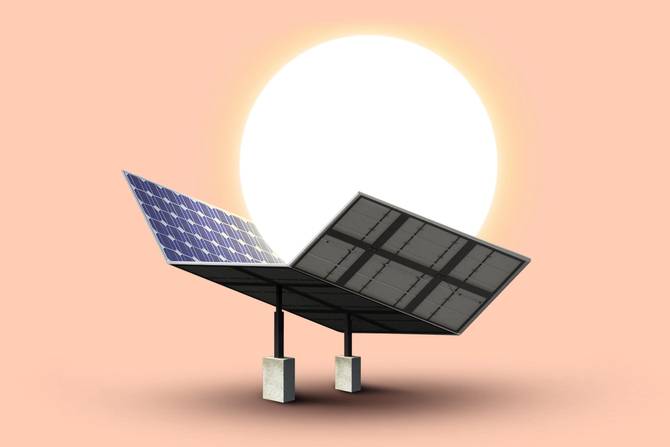Photo Illustration: Dianna “Mick” McDougall, Source: ChampionX
Methane leaks are about to become a lot more expensive.
The Inflation Reduction Act includes a methane emissions fee that would charge oil and gas companies that emit more than 25,000+ metric tons of CO2 equivalent per year at least $900 per additional ton of methane released into the atmosphere.
Why it matters: Methane is more than 25x more potent than CO2 when it comes to trapping heat in the atmosphere and is responsible for about half of current global warming so far. Some of the main sources of human-induced methane emissions are landfill sites, agriculture (you’ve probably heard about the cow farts), and oil and gas extraction.
Quickly identifying leaks at oil and gas sites will be essential in enforcing this new rule and reducing methane emissions, ~30% of which come from fossil-fuel production and use, according to scientists. Luckily, the tech used for monitoring has come a long way in the past decade.
Grounded
Methane emissions used to be measured mostly from the air. Airplanes, helicopters, or—more recently—drones fly over a site and detect the concentration of hydrocarbons in the atmosphere to determine how much methane is being released.
But this method doesn’t take measurements often enough to catch leaks quickly, so the industry is moving toward on-the-ground solutions that can provide more frequent monitoring at these sites.
This tech, which is known as a continuous emissions monitoring system (CEMS) or a point sensor, “sniffs” for methane 24/7.
“The moment that methane is detected, they will immediately trigger an action—somebody to go take a look, figure out what’s coming from it and fix that thing,” Zach Supalla, founder and CEO of the IoT platform Particle, which works with companies monitoring methane leaks, told us. “So you get faster response time, which means, at the end of the day, less methane is emitted.”
Read the full story here.—GD
|
|
Francis Scialabba
Nvidia, the nation’s largest chipmaker by market cap, reported earnings last week—and, in line with the current semiconductor slump, some of the company’s Q2 numbers missed the mark.
Weeks before last Wednesday’s earnings call, Nvidia had already lowered its estimates, but the company still fell short on earnings per share—and on Q3 revenue expectations, which, at $5.9 billion, fell $1 billion short of Wall Street analysts’ predictions. Net income for the company dropped 72% year over year, to $656 million.
“This was a challenging quarter,” Colette Kress, Nvidia’s EVP and CFO, said on the earnings call.
And on Monday, shares fell 8%, continuing a post-earnings report selloff.
From bad to worse: A drop in demand for hardware, like graphics cards and PCs, hit Nvidia’s gaming business hard. Gaming revenue dropped 44% from Q1 and 33% year over year—a decline that was “sharper than anticipated,” Kress added.
The AI engine
There’s a potential bright spot on Nvidia’s balance sheet: its data-center business. The segment grew 61% year over year, although the company said its $3.81 billion revenue still fell short of expectations due to supply-chain issues.
The data-center business’s growth was largely thanks to North American cloud-computing giants. For instance, Pinterest began using 100x larger AI recommender models after it started to use Nvidia’s GPUs, and Tesla “upgraded its supercomputer to use over 7,000 A100 GPUs for autopilot training,” Kress said.
- But the North American sales boost was “more than offset by lower sales to China hyperscale customers affected by domestic economic conditions,” according to Kress.
Looking ahead: Executives are also optimistic about Nvidia’s next-generation H100 compute GPU, which is now in full production and should add to its data-center segment’s growth. Hopper, the underlying architecture, is designed to help train transformer-based large language models, the same kinds of AI models that underpin services like Google Search and Autocomplete.
One other area of growth for Nvidia: its automotive business, which, with $220 million in revenue, up 45% year over year, grew largely thanks to self-driving revenue. The company recently announced new vehicle partnerships with Chinese EV makers like NIO, Li Auto, and Baidu-owned Jidu.
Read this story on site here.—HF
|
|
|
We all want to create a work-life balance that works best for us, but it’s much easier said than done. So we curated tips from some of the best entrepreneurs and business leaders of this era to help inspire you. Start achieving the balance you deserve today—check it out!
|
|
-
Snap will lay off about 20% of its workforce, including some in the company’s hardware division.
-
Honda and LG are teaming up to build a $4.4 billion EV battery factory in the US.
-
Researchers led by ETH Zurich are using AI to explore the dark side of the moon.
-
Royal Caribbean Cruises partnered with SpaceX to offer customers internet access via the company’s Starlink satellite-broadband network, starting immediately.
-
First Solar, a leading solar-panel manufacturer, will spend up to $1.2 billion to build a new US factory and expand production.
-
On September 29, we’re (virtually) convening hundreds of business leaders and innovators to discuss pressing technologies across food, energy, and health. You can now join the event and hear from speakers including Mark Cuban for zero cost. Click here to RSVP.
|
|
-
Chicago lifted its consumer-drone restrictions within O’Hare International Airport airspace, striking fears of drone-to-airplane collisions.
-
The DOE is soliciting feedback from the public on how to spend the $335 million allocated to recycling lithium-ion batteries.
-
The Japanese government vowed to nix laws requiring the use of floppy disks and CD-ROMs when uploading data to the nation’s government agencies.
-
A Tesla owner is suing the carmaker, alleging his Model 3 is prone to phantom braking “randomly and unexpectedly.”
|
|
Catch up on the top Emerging Tech Brew stories from the past few editions:
|
|
|
Chicago, thankfully, has not changed its restrictions on drone usage.
|
|


|
|
Written by
Grace Donnelly and Hayden Field
Was this email forwarded to you? Sign up
here.
 Guide →
What is AI?
Guide →
What is AI?
 Guide →
What is 5G?
Guide →
What is 5G?
WANT MORE BREW?
{if !contains(profile.lists,"Daily Business")}
Get the daily email that makes reading the news enjoyable →
{/if}
{if !contains(profile.lists,"EmTech Brew") || !contains(profile.lists,"HR Brew") || !contains(profile.lists,"Marketing Brew") || !contains(profile.lists,"Retail Brew") || !contains(profile.lists,"IT Brew") || !contains(profile.lists,"Future Social") || !contains(profile.lists,"CFO Brew")}
Industry news, with a sense of humor →
{if !contains(profile.lists,"CFO Brew")}
-
CFO Brew: your go-to source for global finance insights
{/if}
{if !contains(profile.lists,"Future Social")}
-
Future Social: the Brew's take on the world of social media
{/if}
{if !contains(profile.lists,"HR Brew")}
-
HR Brew: analysis of the employee-employer relationship
{/if}
{if !contains(profile.lists,"IT Brew")}
-
IT Brew: moving business forward; innovation analysis for the CTO, CIO & every IT pro in-between
{/if}
{if !contains(profile.lists,"Marketing Brew")}
-
Marketing Brew: the buzziest happenings in marketing and advertising
{/if}
{if !contains(profile.lists,"Retail Brew")}
-
Retail Brew: retail trends from DTC to "buy now, pay later"
{/if}
{/if}
{if !contains(profile.lists,"Money Scoop") || !contains(profile.lists,"The Essentials") || !contains(profile.lists,"Money With Katie")}
Tips for smarter living →
{if !contains(profile.lists,"Money Scoop")}
-
Money Scoop: your personal finance upgrade
{/if}
{if !contains(profile.lists,"Money With Katie")}
-
Money With Katie: manifest your financial freedom
{/if}
{if !contains(profile.lists,"The Essentials")}
-
Sidekick: lifestyle recs from every corner of the internet
{/if}
{/if}
 Podcasts →
Business Casual,
Founder's Journal,
Imposters, and
The Money with Katie Show
Podcasts →
Business Casual,
Founder's Journal,
Imposters, and
The Money with Katie Show
 YouTube
YouTube
Accelerate Your Career with our Courses →
|
ADVERTISE
//
CAREERS
//
SHOP
//
FAQ
Update your email preferences or unsubscribe
here.
View our privacy policy
here.
Copyright ©
2022
Morning Brew. All rights reserved.
22 W 19th St, 4th Floor, New York, NY 10011
|
|






